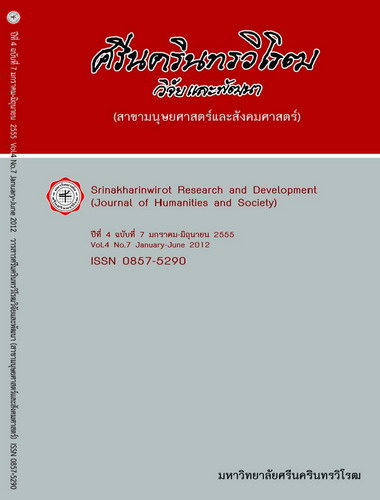นัยสัญลักษณ์พระสมเด็จ: การถอดรหัสทางพุทธศิลป์และความหมายทางสังคมวัฒนธรรมของพระพิมพ์สกุลสมเด็จพระพุฒาจารย์ (โต พรหมรังสี)
Keywords:
The Buddhist votive tablets of Somdej phra buddhajarn (Toe Brommarangs), Decoding, Buddhist art, Socio-culturalAbstract
บทคัดย่อ วัตถุประสงค์ของการวิจัยนี้เพื่อ 1) วิเคราะห์ลักษณะกายภาพทางศิลปะของพระพิมพ์สกุลสมเด็จพระพุฒาจารย์ (โต พรหมรังสี) 2) ศึกษาและวิจักษณ์ความหมายของรูปลักษณ์และสัญลักษณ์ทางพุทธศิลป์ในพระพิมพ์สกุลสมเด็จพระพุฒาจารย์ (โต พรหมรังสี) และ 3) ศึกษาและวิพากษ์ความหมายทางสังคมวัฒนธรรมของพระพิมพ์สกุลสมเด็จพระพุฒาจารย์ (โต พรหมรังสี) ทำการศึกษาจากกลุ่มตัวอย่างที่เป็นพระพิมพ์สกุลสมเด็จพระพุฒาจารย์ (โต พรหมรังสี) จำนวน 25 พิมพ์ ด้วยวิธีการวิจัยเชิงคุณภาพ (Qualitative research) โดยใช้แบบวิเคราะห์ทางศิลปะ แบบวิเคราะห์ความหมายทางพุทธปรัชญาและแบบสัมภาษณ์
ผลการวิจัยพบว่า 1) พระพิมพ์ สกุลสมเด็จพระพุฒาจารย์ (โต พรหมรังสี) เป็นผลงานทางศิลปะประเภทประติมากรรมขนาดเล็กแบบนูนต่ำ (Bass Relief) มีลักษณะที่สามารถจัดหมวดหมู่ได้เป็น 3 ชุดด้วยกัน คือ ชุดรูปทรงสี่เหลี่ยม สามเหลี่ยมและวงกลม มีเอกลักษณ์ที่ภายในรูปทรงมีองค์พระนั่งปางสมาธิฐาน 3 ชั้น 5 ชั้น 6 ชั้น 7 ชั้น และ 9 ชั้น มีเส้นนูนรูปโค้งครึ่งวงรูปไข่รอบองค์พระ จำนวน 1 เส้น การออกแบบมีความสัมพันธ์ได้สัดส่วนจนก่อให้เกิดความงาม 2) รูปลักษณ์และสัญลักษณ์ทางพุทธศิลป์ในพระพิมพ์สกุลสมเด็จพระพุฒาจารย์ (โต พรหมรังสี) มีความหมายที่เกี่ยวข้องกับหลักการปฏิบัติธรรมต่างๆ ที่สำคัญในพระพุทธศาสนา ได้แก่ หลักบุญกิริยาวัตถุ หลักไตรสิกขา คาถาชินบัญชร และปฏิปทาที่เกี่ยวข้องกับสมเด็จพระพุฒาจารย์ (โต พรหมรังสี) 3) ความหมายทางสังคมวัฒนธรรมของผู้คนที่นิยมพระพิมพ์สกุลสมเด็จพระพุฒาจารย์ (โต พรหมรังสี) ได้ถูกแบ่งออกเป็น 2 ลักษณะ คือ 1) ความหมายที่เกิดจากนักนิยมสะสมพระพิมพ์สกุลสมเด็จพระพุฒาจารย์ (โต พรหมรังสี) หมายถึงของมีค่าที่แสดงถึงปางหนึ่งใน พุทธประวัติ มีราคาซื้อขายและมีมหาชนรองรับ 2) ความหมายที่เกิดจากพระภิกษุสงฆ์และฆราวาส หมายถึงเป็นตัวแทนของสมเด็จพระพุฒาจารย์ (โต พรหมรังสี) และเป็นเครื่องสืบทอดพระพุทธศาสนาให้ดำรงอยู่ต่อไป
The objectives of this study are to: 1) Analyze the physical characteristics of the art of Somdej Phra Buddhajarn (Toe Brommarangsi); 2) Study and Appreciate the meaning of the physical characteristics and symbols of Buddhist art by Somdej Phra Buddhajarn (Toe Brommarangsi); and 3) Examine and Critique the meaning of society and culture of Somdej Phra Buddhajarn (Toe Brommarangsi) based on a sample group of 25 printed documents by applying a qualitative research approach to art analysis, meaningful analysis of Buddhist philosophy, and interviews.
The results show that: 1) Somdej Phra Buddhajarn (Toe Brommarangsi) votive tablets are an art form representing themes in small sculptures (bass relief in amulet form) which may be categorized into three sets according to shape. These categories-square, triangular, and circular-are unique to the shape of the Lord’s seated image atop a base ranging in height from 3 to 9 tiers. An elliptical band surrounding each figure provides aesthetic symmetry to the image. 2) The appearance and symbols of Buddhist art by Somdej Phra Buddhajarn (Toe Brommarangsi) derive their meaning from the association with various principles, which are important meritorious actions in the practice Buddhism. These include Threefold Learning, the prayer Shin Banchorn, and modes of progress to deliverance with Somdej Phra Buddhajarn (Toe Brommarangsi). 3) The socio-cultural meaning of the works of Somdej Phra Buddhajarn (Toe Brommarangsi) in the minds of the people is divided into two types: 1) The meaning accorded by collectors of Somdej Phra Buddhajarn (Toe Brommarangsi) illustrates the value of these works in their purchase price and public support. 2) The meaning in the eyes of monks and laymen of the works of Somdej Phra Buddhajarn (Toe Brommarangsi) represents a medium of the continued transmission of Buddhist principles.
Keywords:
Downloads
Downloads
Published
How to Cite
Issue
Section
License
Srinakharinwirot Research and Development Journal of Humanities and Social Sciences is licensed Under a Creative Commons Attribution-NonCommercial-NoDerivs 4.0 International (CC-BY-NC-ND 4.0) License, Unless Otherwise Stated. Please Read Journal Policies Page for More Information on Open Access, Copyright and Permissions.



